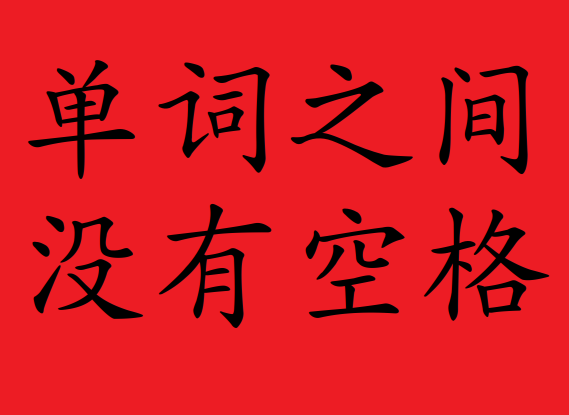Written Chinese doesn’t use spaces between words, but modern Chinese does use punctuation, so you can still tell where one sentence stops and the next starts. With Chinese words being multiple characters, a Chinese reader relies on experience to know where one word stops and the next start. Chinese Beginner books and learning material often places spaces between words to make it easier for learners to distinguish words from one another.
Chinese sentence examples
Consider the sentence “I like to go to the park”, which is written as
|
|
|
|
|
| wǒ | xǐhuān | qù | gōngyuán |
| I | like | go | park |
If you are familiar with the Chinese words in this example, you’ll be able to read it despite the lack of spaces, but how does this work if you don’t know the characters and words or are just beginning to learn Chinese? Beyond relying on beginner learning material to add in spaces, there is a rule of thumb you can use:
Nearly 95% of Chinese words are one, two, three or four characters long and nearly half of Chinese words are two characters in length. Check out our FAQ question Are Chinese characters words? where we analysed the length of nearly 120,000 words from our Chinese – English dictionary.
Knowing that most Chinese words are four characters or less and most are typically two characters, can help in knowing which characters belong together in a sentence. To demonstrate this let’s look at the sentence that is used as the thumbnail image for this article:
No spaces, no problem
To further demonstrate how sentences without spaces could work in English, consider the following English sentence with spaces removed:
whattimeisitnow?
Even without the spaces, you can probably work out that this sentences is “what time is it now?”
For comparison, let’s look at the translation of the above English sentence in Spanish:
quéhoraesenestemomento?
Assuming you don’t speak Spanish, you probably have no idea where once word stops and another starts. These two examples demonstrate how a person who is literate in a language can read a sentence,even without spaces.
But when learning Chinese you won’t instantly know all common words, so won’t the lack of spaces be confusing? Consider this example in English:
hewasguttedwhenhelosthiswallet
Even if you don’t understand the word “gutted” and despite the lack of spaces between words, you can probably still read the sentence, and may even guess that “gutted” means “upset”. The point here is that even if a Chinese reader didn’t understand a word, they are still able to read there characters around it, despite the lack of spaces showing where one word starts and another finishes.
Wrapping it up
If you’re plan to start learning Chinese or already are, you will need some time to build up some basic character and word knowledge before being able to navigate written Chinese. Learning to read Chinese isn’t as difficult as you thin, with most learner material providing you plenty of help. Knowing where one word ends and another starts in Chinese is never a significant problem for most learners.

